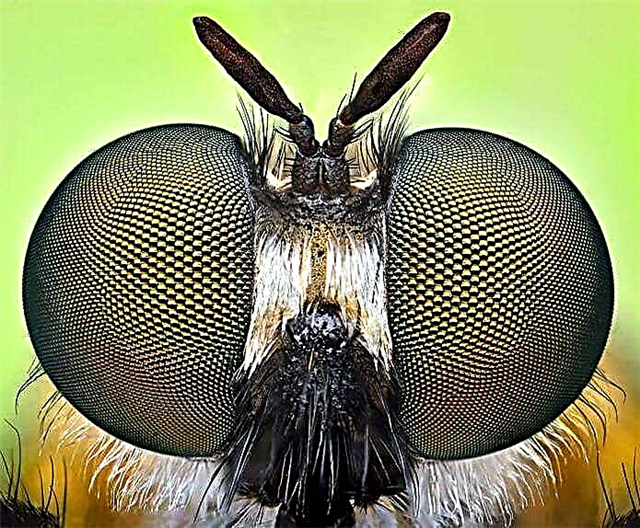
Traveling birds, whose migration range is truly planetary in nature, have to rely on global orienting fields, due to the fundamental physical properties of the globe and the surrounding space. Especially a lot of hopes for understanding the orientation mechanisms of migratory birds gave rise to a geomagnetic field among ornithologists, the presence of which distinguishes the Earth from all the nearest planets of the Solar system.
The mechanisms of bird migration

With a certain degree of conventionality, the Earth can be imagined as a giant magnetized ball. At every point on the surface of the globe there is a magnetic field, the direction of which is easy to establish using the compass needle, which is always facing the magnetic pole. Recall that the planet’s magnetic poles lie somewhat away from the geographic poles drawn on a map or globe through which the Earth’s rotation axis passes.
The arrow of a conventional compass moves only left and right, therefore, it shows the direction of only the horizontal component of the field, being directed along the magnetic meridian to the Earth’s magnetic pole. But the forces of terrestrial magnetism act not only in the horizontal plane, but also towards the center of the planet, that is, the magnetic field also has a vertical or, as they say, gravitational component. If the compass needle could move in all directions, including up and down, then its position would noticeably change as it moves from the equator to the poles.
At the equator, it would be located strictly parallel to the surface of the Earth, that is, absolutely horizontally, pointing with its magnetized end strictly north. As it moves away from the equator, its deviations from the horizontal would become more noticeable and finally at the north pole the arrow would turn to the center of the planet, that is, it would rise vertically. At the south magnetic pole, the arrow will also occupy a vertical position, but its magnetized “north” end will be facing strictly up. Thus, a compass having such a device can be used not only to indicate the direction to the north, but also to determine its position on the meridian, that is, as an indicator of latitude.
Hypothesis of the magnetic orientation of migratory birds
Can birds use terrestrial magnetism in the same way as we use a conventional compass, the arrow of which, obeying the horizontal component of the magnetic field, is always facing north? Are birds able to feel and appreciate this component? The hypothesis of the magnetic orientation of migratory birds was expressed by the academician of the St. Petersburg Academy A. Middendorf more than a hundred years ago, however, scientists only appeared to have real experimental verification of it in recent years.
A method of studying bird migration
It turns out that pigeons with spirals made of thin metal wire on their heads with electric current flowing through them from miniature batteries in experiments on cloudy weather did not return home well. In clear weather, they used the familiar solar compass and confidently headed towards the dovecote, not at all sad that the direction of the magnetic fields surrounding their heads had nothing in common with the direction of terrestrial magnetism.
In cloudy weather, pigeons with spirals on their heads made gross mistakes when plotting the course and flew far away, while pigeons without spirals did not experience noticeable difficulties. To date, there is much more evidence of the ability of birds to use a magnetic compass. Much more doubt is caused so far by the ability of birds to use the gravitational component of the magnetic field in order to determine their location.
Earth rotation and bird migration
At one time, it was even suggested that birds had navigation methods based on the use of Coriolis forces. These forces arise due to the rotation of the globe; they increase in the direction from the pole to the equator in accordance with the increase in the speed of rotation of points located on the surface of the earth's sphere. The global manifestations of the Coriolis forces on a planetary scale are leaching of the banks of rivers flowing in the meridional direction, and the twisting of gigantic atmospheric vortices. The use of these forces is based on the design of a gyrocompass - a device that, at any positions of an aircraft or sea vessel, spontaneously sets up along the geographical meridian. Coriolis forces are suitable in order to determine the geographical latitude within one hemisphere.
If we add one more place indicator, for example, one of the components of the Earth’s magnetic field, then we can get the desired system from two coordinates (due to the mismatch between the axes of magnetism and rotation), which allows us to create a magnetic-gravity map. However, the calculations showed that in order to be perceived by the birds, the Coriolis force is still too small and, in particular, hopelessly overlap and mask by the accelerations that affect the bird in flight (on take-off, during acceleration or deceleration, and indeed when any change in flight speed or position in space).
Bird navigation
The difference between compass orientation and navigation
Going to the goal includes two components. Firstly, compass orientation — the ability to maintain a chosen course for a long time, and secondly, navigation — the ability to plot a course between two points based on a comparison of their coordinates, that is, on a map stored in memory.
The differences between simple compass orientation and navigation are illustrated by the experience of transporting starlings. Several thousand birds were caught and ringed, transported from Holland to Switzerland and released. Young birds, who made the first migration in their lives, headed from Switzerland to the southwest. They managed to choose the right direction, but they eventually deviated from the course and were noticeably south of the place to which they were headed, and accordingly they had no choice but to winter in Spain and the southern regions of France.
According to the compass, the youngsters orientated correctly, but the starlings could not afford to correct for a certain shift from their usual route. And adult starlings, who already had migration experience, perfectly showed that they have excellent sniper navigation. They were able to navigate and immediately set a new course in the north-western and western directions and as a result they easily reached their usual wintering.
The difference between the spatial orientation of adult and young birds
What is the difference between the spatial orientation of adult and young birds? Most likely, the movement for wintering in young animals, overcoming the route for the first time in their lives, is subordinated mainly to instinctive programs of behavior. In other words, the young starling has the innate ability to fly in the direction of wintering and quite accurately imagines exactly what distance it needs to overcome in order to reach them.
Another thing is adult birds that have already visited winter apartments and received certain information there. Which one is the most difficult and key question, the exact answer to which does not yet exist. This can be any astronomical or geophysical information, through which it is possible to give a unique characteristic of any point on the surface of the globe. So, an adult bird is most likely able to compare stored wintering information with current information about its location.All further is a matter of technology and is a simple task for any subject who knows the skills of orientation using a compass.
The ability of pigeons to find their way to the house
The amazing ability of pigeons to find their way to the house has been known since time immemorial. The armies of the ancient Persians, Assyrians, Egyptians and Phoenicians sent messages from campaigns with pigeons. During both world wars, the pigeon post served such a service that monuments were erected in honor of the feathered letter-carriers in Brussels and the French city of Lyon. At competitions, carrier pigeons are transported for 150-1000 kilometers and released. The time of return of birds to the dovecote is recorded using special devices. Well-trained pigeons fly to the house with an average speed of 80 kilometers per hour, the best of them are able to overcome 1000 kilometers per day.
The third monument to the pigeons has not yet been built, but they have long been deserved due to their outstanding contribution to the study of the ways of orientation of birds. It turned out, for example, that pigeons can come back from far away to the dovecote despite the strongest “shortsightedness”. The “near-sighted” birds were made for the duration of the experiment, putting matte contact lenses on their eyes, which made it possible to distinguish only the contours of the nearest objects. And with such lenses, pigeons were released 130 km from the dovecote. Half-blind birds soared upward and rushed home at high altitude, not seeing anything around them except an impenetrable gray fog. Almost everyone managed to safely get to the place, although "myopia" did not allow to find the dovecote itself. Pigeons descended within a radius of 200 meters from her and patiently expected to get rid of annoying lenses.
Bird compasses
When a course is known, you can follow it for a long time only with the help of a compass. Depending on the circumstances, birds confidently use “compasses” of at least three different types. In the daytime, birds with great accuracy determine the position of the cardinal points on the sun. This is not prevented even by a light shroud of clouds as long as it still allows you to feel the position of the star in the sky. At night, the stellar “compass” comes to replace the sun, and in the art of handling it, many birds performing night migrations also achieved great success. When the weather deteriorates completely and the sky is covered with clouds around the clock, a magnetic “compass” comes to the rescue of feathered travelers, with which they also manage very skillfully.
Thus, to the question of what “compass” feathered travelers use, scientists have an almost comprehensive answer. The situation is worse so far with an understanding of what the “navigational map” of birds is and what methods they use to mark their location on it. Recall that sailors have learned to do this for real only with the advent of accurate measuring instruments.
First of all, a chronometer — a watch with a very accurate progress, allowing you to track the altitude of the stars above the horizon and their azimuth at a strictly defined hour during a many-month voyage — that is, their location in relation to the direction to the north. The position of the luminaries is determined with the help of a sextant - a rather complicated instrument, without which over the course of the last three centuries not a single long-distance vessel left the port. To "get a place" of the ship, it is necessary to do at least two measurements of the altitude or azimuth of the stars - in any combination.
Having obtained the necessary numbers with the help of navigation tables, partially freeing the navigator from complex calculations, he can determine the geographical longitude and latitude, with which the vessel was at the moment of measurement, with an accuracy of several miles. More accurate, but incomparably more expensive navigation methods, suggesting the position of a ship or aircraft with an accuracy of tens of meters, became possible only with the advent of space vehicles.
Solar and star compasses
Thus, according to the position of the Sun or stars in the sky, one can not only maintain the course using luminaries as a substitute for a compass, but also determine one’s position on the planet’s surface using luminaries as indicators of a place. Currently, it is firmly established that birds have the innate ability to use solar and starry “compasses”, due to the presence of accurate “internal clocks”, allowing you to choose the right direction for any position of the stars during the day.
Can birds use the sun and stars to determine location?
If the evolution of bird navigation systems would follow the same path as the development of navigational affairs, then the birds would have to find a replacement for the chronometer, sextant, calendar and, moreover, master the sum of knowledge in astronomy at least in the volume of the secondary school program. Then, finding himself in an unfamiliar area, the same carrier pigeon could determine its position in relation to the house, evaluating the difference between the height of the sun and the azimuth of the stars in the new place and the stored height and azimuth of the same stars on the same day and then same time above the native dovecote.
The easiest way is to wait at a new place for the onset of local noon - the moment of the upper culmination of the center of the Sun. Then two things should be done. Firstly, look at the clocks running at "home" time, and establish the difference in the moment of noon. If the Sun went to the zenith before 12.00, then the house remained in the west, if later - in the east. Secondly, you need to look at the Sun and evaluate its height above the horizon. If the Sun at noon is higher than at home, then fate has brought you south, if lower - south to north (in the Southern Hemisphere, of course, vice versa).
At first glance, everything is simple, but in reality the difficulties are indescribable. To use this method, even in its simplest modification, you need a huge amount of memory and the highest measurement accuracy. The brain of birds does not have such memory resources. In addition, measurements for navigation purposes are too complex to be able to be made “by eye”.
For example, at the latitude of the city of Simferopol, for every 100 kilometers of the way, the height of the Sun changes by only 1 °, the time of sunrise and sunset - by less than 5 minutes, the azimuth of the Sun - by less than 1.5 °. Using astronomical orientation is easier over long distances - as it decreases, the requirements for measurement accuracy are steadily increasing.
Ornithologists have worked hard to find similarities in the methods of navigation of birds and people. But all studies in this direction have not yet been successful. Most likely, the birds determine their location on the surface of the Earth and draw their "maps" in other ways. Which ones - this remains to be seen in the future. This is how a well-known specialist in the field of bird migration sees St. Petersburg professor V.R. Dolnik: “We have to admit,” he writes, “that the navigation system leads the birds to a point - in the most literal sense of the word, in which they once received (or from which they continue to receive) some information.
Obviously, the accuracy limits of systems known to us that provide astronomical, geomagnetic or gravitational navigation in birds are 2-3 orders of magnitude insufficient for navigation to a point. This again (as in the study of homing pigeons) raises the question of some unknown factor that allows us to mean absolute navigation, or a known factor, but an unknown way of using it for navigation. ”












